The rebirth of suspended (drop-in) grid luminous ceilings
by arslan_ahmed | June 9, 2023 8:00 pm
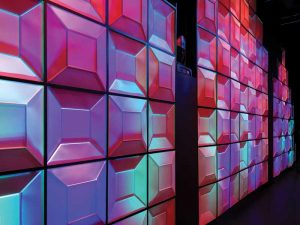 [1]
[1]By Ed Davis, Ben Carr, and Steven H. Miller, CDT
A suspended (drop-in) luminous grid ceiling is a multi-functional architectural element that forms a major decorative surface. It keeps unsightly overhead mechanical services concealed but accessible, while hosting lighting and other fixtures and providing thermal/acoustic control.
In the middle of the 20th century, the ceiling itself started to be used as a source of illumination. Luminous ceilings, composed of fluorescent troffers above the ceiling that shone down through light-transmitting ceiling panels, were all the rage. The concept is now having a resurgence—updated and improved by the use of light-emitting diode (LED) light sources that deliver more versatile illumination at much greater energy efficiency.
Luminous ceilings have benefits for numerous different applications, ranging from banquet halls to offices and hospitals. Light-transmitting panels, available in a range of decorative patterns and sized for “universal” grids, offer the designer opportunities to create simplified yet beautified ceilings with versatile functionality.
Function
Luminous ceilings typically provide even, diffused illumination in the space below them. Unlike point sources of light, this illumination comes from an infinite number of angles, reducing or eliminating shadows. Light intensity is dependent on output of light sources and spacing of those sources above the ceiling. With LEDs, output is often variable and controllable. RBGW (red, blue, green, white) LEDs also allow the color to be changed in a range of hues. Some control systems even allow light levels to be pre-programmed for different parts of the day or for specific events.
While there are other types of luminous ceilings, such as stretched fabric, suspended grid ceilings offer the highest versatility and functionality, while being an affordable option. Similar to opaque drop-in ceilings, the luminous versions conceal unsightly mechanical services above the ceiling plane (e.g. HVAC ducts, electrical and IT raceways, plumbing, etc.), but allow easy access to them for maintenance or repair. If drop-out panels are used, even fire suppression sprinkler systems can be removed from view. This is further discussed in the ‘design considerations’ section of this article.
A luminous ceiling is ideal in situations where diffuse light is desirable. It can be either the primary light source, or a background wash of light—including colored light—that supplements point sources.
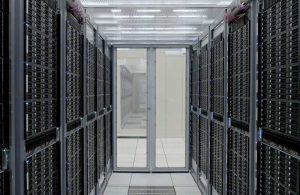 [2]
[2]For example, a chain of Pilates studios in Southern California uses luminous ceiling illumination exclusively in their workout rooms. Exercisers lying on their backs on the Pilates equipment are staring straight at the ceiling, and a conventional light fixture would inevitably assault them with uncomfortable glare. Backlit translucent panels present a soft, gentle glow that creates a peaceful environment, and the decorative pattern of the panels offers the eyes relief and provides something aesthetically pleasing to focus on.
Form
Apart from their illumination function, luminous ceilings make aesthetic contributions to design. When a large proportion of ceiling emanates light, it transforms the appearance and effect of a room. It can raise the apparent ceiling height and make the space feel more expansive. Even at lower illumination levels, it has an emotional effect, making the room more welcoming, calm, and filled with a kind of uplift.
Panels for luminous ceilings are typically made of lightweight, molded plastic, such as rigid vinyl. They are available in different degrees of diffusion. For example, one leading manufacturer makes three degrees of diffusion labeled clear, frosted, and translucent, with clear having the least diffusion and translucent having the most. Diffusion affects both the spreading of light and the extent to which the ceiling reveals or conceals the above-ceiling area.
Many luminous ceiling products feature 3D (bas relief) patterns, enabling wide-ranging design choices. They are a stark contrast to the most familiar panel for suspended grids—opaque flat panels whose 2D surface contributes little to most architectural styles.
The range of available decorative patterns is wide and includes both contemporary and traditional options. Patterns emulate ornate decorative plaster commonly found in 19th century architecture, stamped metal (tin ceilings) popular in the early 20th century, coffers, which have been a feature of luxury residential and institutional construction since Ancient Rome, and geometric patterns such as circles, lines, wedges, stylized flower petals, and more.
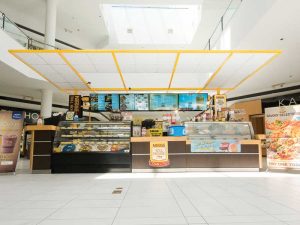 [3]
[3]Some manufacturers offer the same panel patterns in both translucent and opaque versions, with opaque versions in several colors and faux finishes including wood and metal. Designers can integrate luminous sections into an otherwise opaque ceiling while maintaining a uniform design, or mix patterns to create a stylistic differentiation between luminous and opaque sections.
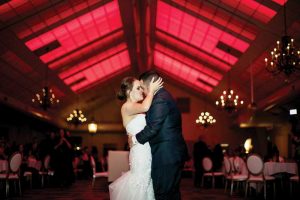 [4]
[4]If color-controlled RGBW LED’s are used as above-ceiling illumination sources, ceiling color, as well as the entire room’s appearance and mood, can be changed at the touch of a button. The Bavaria Downs wedding venue, in Chaska, Minnesota, features a large luminous area in the central 50 percent of the double-slope ceiling, resembling a vast skylight, with opaque panels of a different pattern along the lower edges of the slopes (Figure 1).
Bavaria Downs’ designer Ed Hawksford was seeking an effect that recalled early 20th century Lalique glass. For illumination, he paired the color-controlled luminous ceiling with crystal chandeliers, affording a wide flexibility of effects. Luminous areas of the ceiling are lit by economical generic RBGW LED strips, located approximately 508 mm (20 in.) above the ceiling panels and spaced 0.6 m (2-ft) apart. They are operated by DMX controllers, a programmable system for theatrical lighting. The system can create whatever colors are required to suit an event. The ceiling can mimic a vast skylight with the blue of high noon or the pink of sunset. It can present a background wash of color that matches the bridesmaids’ gowns, while the chandeliers provide directed light that accents glamour and makes the food sparkle. Later, chandeliers can be dimmed to create a soft glow and the ceiling can offer colors in dramatic, saturated hues for dancing. The ceiling can even by synced to music to create a light show. This versatile ceiling has become a sales-point for the venue, with customers considering it additional free decor.
Luminous ceilings, therefore, can be a major design element in addition to the more conventional functions of a suspended grid ceiling.
Applications
There are a broad range of applications where luminous ceilings may be useful or desirable because they offer several different types of benefits: diffuse lighting, transmission of borrowed light, color and intensity control, and improved appearance. In some applications, more than one benefit comes into play.
| RENEWING EXISTING LUMINOUS CEILINGS |
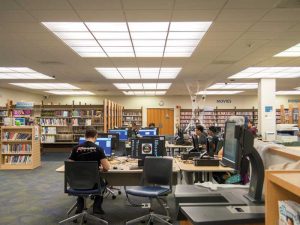 [5] [5]Facilities with older luminous ceilings can benefit by replacing elements of their existing systems with new technologies. Lenses of these older systems are often acrylics that turn yellow and darken with age. Replacing them with new panels may increase light output and restore illumination levels that were intended in the original design. LED tubes and high-efficiency ballasts compatible with old fluorescent troffers are available as well, and can decrease energy consumption without needing to replace entire fixtures. |
Hospitality
Soft, diffuse lighting is ideal for several types of hospitality environments. In restaurants, it can create a more intimate atmosphere. For example, indirect lighting is one of the must-have features for a five-star rating by the prestigious Michelin guide. Color-controlled lights can transform the decor for special occasions. Ballrooms can benefit from this transformational capability. There are many areas of hotel operations where luminous ceilings may be appropriate and useful, including guest rooms, corridors, lobbies, work-out rooms, and indoor swimming pools.
Exercise and fitness
Exercise and fitness facilities often have situations where occupants spend significant time looking upwards, such as the Pilates studio cited above. Luminous ceiling eliminates glare and makes exercise more comfortable. Decorative patterns in the ceiling form an added benefit of making the space more visually interesting and providing eye relief. In some yoga methods, fixing the gaze on a point in the ceiling is part of the practice.
Applicable environments for luminous ceilings include gyms, workout rooms, swimming pools, and yoga studios, both stand-alone facilities and those found in offices, hotels, schools, recreational centers, residential developments, and senior living residences.
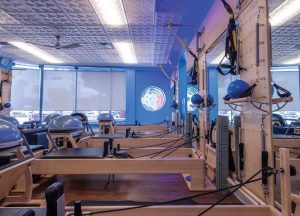 [6]
[6]Healthcare
Similarly, many healthcare practices have patients lying on their backs and staring upward at some point during examination or treatment; for example, doctor’s examination rooms, hospital patient rooms and corridors, and dental practices. In all these applications, luminous ceilings have the benefit of visual interest and the elimination of glaring point light sources.
Hospitals have also reported operational benefits from switching to variable intensity color-controlled lighting. When McLaren Healthcare System in Michigan, upgraded their 11 primary hospitals with LED systems, they found they could reduce noise levels by controlling the lighting. Dimming the lights in patient and visitor areas at 8 p.m. signaled it was time to quiet down and allow patients to rest.
Hospitals can also utilize color adjustment to help both patients and staff. In patient rooms and wards, they can simulate the color of sunlight during the daytime, and at night, provide low blue-levels that are more conducive to sleep. In the nurse’s stations or resident’s break rooms, a color balance more closely resembling sunlight can help nightshift workers stay alert and ward off burnout.
Schools and libraries
Diffuse lighting is helpful in libraries and certain school instruction spaces, especially where computers are used and eliminating glare on monitors can help create a better working environment. Diffuse lighting may also be more calming and facilitate concentration.
Arbor Park School District 145, in a suburb of Chicago, installed luminous ceilings as part of a tightly budgeted renovation of the computer lab in the Morton Gingerwood Elementary School. The frosted ceiling looks attractive, and provides even, glare-free light for students.
Workplaces
Color-controllable lighting may have productivity benefits for a wide variety of workplaces that run late or implement a 24-hour work shift. Since diffuse lighting is good for spaces where computer screens are in use, minimizing glare and screen reflections makes working easier and reduces worker burnout. In places where the color-accuracy of the screen image is important, such as architecture firms, graphics studios, advertising agencies, and video-editing suites, controllable and consistent lighting levels and color are crucial to workflow, and diffuse lighting is ideal for the activities in those environments.
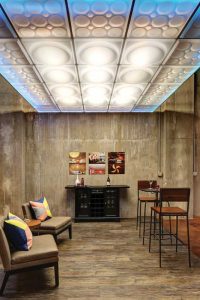 [7]
[7]Room within a room
When a room is constructed within a larger room, for example, a sales office on the floor of a spacious, open car dealership, or a conference room in an open-plan office, a luminous ceiling can eliminate or reduce the need for lighting the smaller room individually. Borrowed light from the larger room’s general illumination may supply some or all the lighting necessary, and perhaps may be supplemented by directed task lighting. Transparent panels may be used, since diffusion is often unnecessary to spread borrowed light and eliminate hot spots.
The same strategy can be applied to kiosks in shopping malls or airport terminals. A ceiling may be needed to protect food preparation areas from falling debris, as was the case of certain Nestle Toll House by Chip restaurants, where translucent ceiling materials allowed the kiosks to meet health code requirements while borrowing light from the larger mall. Adding a ceiling also provides a sense of enclosure that defines the stand’s space and makes it feel more substantial.
Another version of this concept is found in computer data centers that use cold aisle containment systems to maintain computer-friendly environmental temperature. Facilities such as the Gadi supercomputer in Australia or CERN in Switzerland have aisles of servers that must be cooled to compensate for heat generated by high-powered computers. Cold air is pumped into aisles between server-racks through a raised floor, and is retained by transparent ceiling panels across the tops of the racks. By using transparent panels, general illumination from above can light aisles while preserving energy efficiency.
Design considerations
When designing luminous ceilings, the maximum desired illumination level (light intensity) must first be established. This usually depends on the type of occupancy and activities performed there. Illumination level is determined by the interaction of three elements: the output of the LED sources, spacing and density of the LEDs, and the degree of light transmission afforded by the ceiling panels.
LED strip output should be available in basic product data. Translucent ceiling panel product data also typically includes light transmission.
The spacing of LEDs on the strips and the number of strips per panel affect the overall light output of the ceiling. If a modest color wash is desired, strips may be spaced further apart. If high light intensity is needed, more strips with more LED’s may be required.
The degree of diffusion of a ceiling panel affects several aspects of design, including illumination level. Typically, lower diffusion yields greater light transmission, but with more tendency to produce hotspots. Higher diffusion may have significantly lower light transmission, but will be able to eliminate hotspots more effectively at closer distances between light sources and ceiling plane.
Available height above ceiling plane should also be considered. While LEDs tend to produce directional lighting, their light does spread somewhat, increasing at a greater distance from the source. As with all light sources except lasers, LED light intensity varies as the inverse square of distance from the source. Placing LED strips or tubes further from the ceiling eliminates or reduces hotspots and can influence the needed degree of diffusion. If above-ceiling height is limited, higher diffusion levels may be necessary to produce even lighting without hotspots.
In situations with minimal above-ceiling height, LEDs can be placed close to the ceiling plane and inverted, where they shine onto the above structural ceiling or underside of the roof. Covering that upper surface with high light-reflectance material, such as white or aluminized insulating panels, reflects LED-generated light back downward onto the luminous ceiling while spreading it more evenly. To avoid shadowing, inverted LED strips can be placed over or adjacent to grid lines.
The ability of a luminous ceiling product to diffuse light and eliminate hotspots at a given distance can be tested relatively easily. One enterprising lighting designer obtained ceiling panel samples and built a “down and dirty” test chamber using a 609 x 609 mm (24 x 24 in.) cardboard box. He discovered the translucent panel he had obtained was able to diffuse LED light evenly with no visible hotspots, at as little as 152 mm (6 in.) distance. He had been expecting to use inverted LEDs reflecting off roof insulation panels, but his home-made test changed the plans. He had greater above-ceiling height available and was able to place the LEDs facing downward 508 mm (20 in.) from the ceiling. Compared to pointing LEDs upward, this increased illumination levels with a given density of LED sources.
Aesthetic effects of different diffusions are significant. Clearer materials reveal more of the above-ceiling area and its installed structures. Higher diffusion creates the effect of a surface that emanates light evenly all over the area and may mimic a skylight more effectively.
Light-transmitting panels vary in the degree of acoustic control they offer. Heavy panels will tend to reflect sound, whereas lightweight materials, such as thermoformed panels, can provide significant acoustic control up to a noise reduction coefficient (NRC) of 0.85, greater than many opaque mineral fiber acoustic ceilings.
In occupancies that require fire suppression sprinkler systems, plumbing installed closer to the ceiling than LEDs, including drops for penetrating sprinkler heads, can throw shadows onto panels. To eliminate penetrating sprinkler heads and plumbing shadows intruding into the luminous effect, translucent drop-out panels may be used. Drop-out ceilings were invented in the 1960’s for this specific purpose.
In drop-out applications, sprinkler heads are installed above the ceiling plane and above the level of the light sources, so they cast no shadows. Drop-out panels are designed to soften, deform, and fall out of the grid when exposed to heat generated by a fire, at approximately 49 C (120 F). When heat reaches 55 C (130 F), it activates sprinkler heads and their water has clear access to the room below.
Select light transmitting panels that are approved for use as drop-out panels. Drop-out ceilings are acceptable in some types of occupancies, depending largely on the amount of combustible material stored or used in the facility. However, the authorities having jurisdiction (AHJ) may approve or disapprove drop-out ceilings on a case-by-case basis. Therefore, it is advisable to consult the AHJ and submit product data and approvals early in the design process, to make sure a drop-out ceiling is acceptable for the project. (For a more complete discussion of drop-out ceilings, see The Construction Specifier‘s June 2022 article: “Why fire sprinklers belong above suspended drop-out ceilings[8]”).
Conclusion
Luminous ceilings are a versatile addition to the design professional’s toolbox. With the broad range of panel patterns available, design possibilities are virtually endless. Using modern light sources, they can help hit energy-efficiency targets. Diffuse lighting from above meets occupancy needs in
many situations without expensive luminaires or concealed lighting structures. The simplicity and elegance of this lighting solution can also help projects stay within budget while presenting an expensive, upscale appearance.
Author
 Ed Davis is the president of Ceilume, a leading manufacturer of thermoformed ceilings located in California.
Ed Davis is the president of Ceilume, a leading manufacturer of thermoformed ceilings located in California.
 Ben Carr is customer service manager at Ceilume and has 16 years of experience helping customers find ceiling solutions.
Ben Carr is customer service manager at Ceilume and has 16 years of experience helping customers find ceiling solutions.
He can be reached at pro@ceilume.com.
 Steven H. Miller, CDT, is an award-winning freelance journalist and marketing communications writer specializing in issues of the construction industry. He can be reached at steve@metaphorce.com.
Steven H. Miller, CDT, is an award-winning freelance journalist and marketing communications writer specializing in issues of the construction industry. He can be reached at steve@metaphorce.com.
- [Image]: https://www.constructionspecifier.com/wp-content/uploads/2023/06/Ceilume-BlueRidgeChurch-ObliqueView.jpg
- [Image]: https://www.constructionspecifier.com/wp-content/uploads/2023/06/Ceilume-CERN-cold-aisle.jpg
- [Image]: https://www.constructionspecifier.com/wp-content/uploads/2023/06/CeilumeLuminousCeiling-Nestle-NewPark-Front-2021-10-michael-edit.jpg
- [Image]: https://www.constructionspecifier.com/wp-content/uploads/2023/06/Ceilume-Bavaria-Downs.jpg
- [Image]: https://www.constructionspecifier.com/wp-content/uploads/2023/06/Ceilume-Anaheim-Library.jpg
- [Image]: https://www.constructionspecifier.com/wp-content/uploads/2023/06/Ceilume-Club-PIlates-West-LA.jpg
- [Image]: https://www.constructionspecifier.com/wp-content/uploads/2023/06/Ceilume-ceiling-two-patterns.jpg
- Why fire sprinklers belong above suspended drop-out ceilings: http://Why%20fire%20sprinklers%20belong%20above%20suspended%20drop-out%20ceilings
Source URL: https://www.constructionspecifier.com/the-rebirth-of-suspended-drop-in-grid-luminous-ceilings/